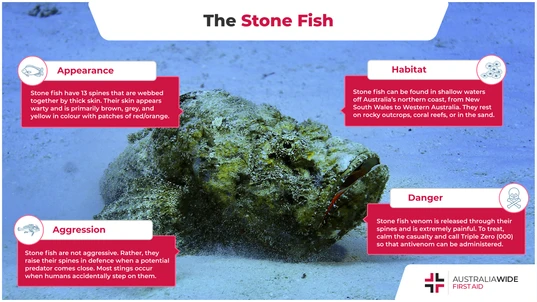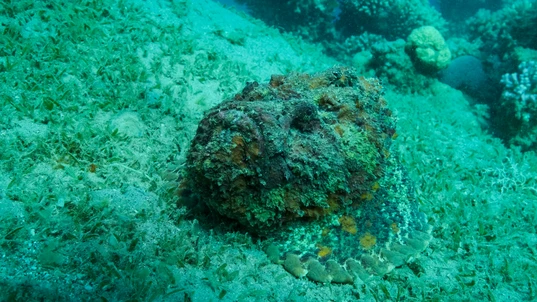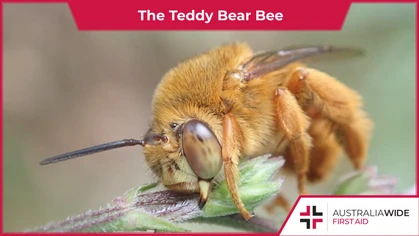Deadly Marine Life: The Stone Fish

Bites and Stings

The sting from a stone fish is excruciating and can be lethal. Prompt and appropriate first aid may reduce the severity of the injury.
The stone fish’s memorable appearance and widespread label as “the most venomous fish in the world” inspires curiosity worldwide. But for Australians and tourists, the stone fish is more than a curious species – it presents a genuine danger. Their unique skin allows them to camouflage as rock and coral; when a threat is close, they raise their dorsal spines. If a human or predator is punctured by one of the spines, the stone fish delivers a venomous sting, causing painful reactions and potentially death. With summer approaching, Australians will be flocking to the water and into the natural habitat of stone fish. To keep you safe this summer, we will cover everything you need to know about stone fish, including how to avoid them and what to do if you encounter one.Identification
The stone fish looks more like rock or coral than like a fish. Rather than shiny scales, it has rough and tough skin. It appears warty and uneven and lacks a colour pattern. It appears primarily brown, grey, and yellow but may have patches of red or orange. The variability of its colouration makes for excellent camouflage. According to Queensland Museum, its typical length is 28 cm, but it can reach lengths of 47 cm. It has 13 spines webbed together by a thick skin. The Australian Museum reports two species of stone fish that live off the coasts of Australia. The Reef Stonefish and the Estuarine Stonefish. Distinguishing between the two species is relatively simple – the Reef Stonefish has a bony ridge between its eyes, and the Estuarine Stonefish has a depression between its eyes.Distribution and Habitat
The habitat range of stone fish is extensive. They can be found in the waters of nearly every part of the northern Australian coasts from New South Wales to Western Australia. They swim in deep and shallow waters, resting and camouflaging on rocky outcrops, corals, and sandy bottoms. They are not schooling fish, so they are most often encountered singularly. Their diet of small fish and crustaceans leads them to shallow waters in search of food. In shallow water is where most human contact occurs.Diet
Stone fish eat crustaceans and small fish. They only use their spines and venom to defend against threats, not to hunt for food. Stone fish often camouflage themselves in their surroundings, wait for crustaceans and fish to come within range, then strike with magnificent speed. Saving their venom for predators, they disable and eat their prey with powerful jaws.
The power of the stone fish is its camouflage.
Danger to Humans
The hunting grounds of stone fish – shallow sandy and rocky areas near the coast - are the favourite play spaces of humans, particularly in the summer. They are not aggressive fish. They raise their spines in defence when a potential predator comes close. Stone fish stings most often occur on the feet when humans accidentally step on their spines. When contact with a spine occurs, venom is delivered from a gland at the base of the spine, along the spine, and into the contact site. Contact with more than one spine means more venom is delivered. The venom causes an extremely painful reaction. Though the reaction can lead to severe injury and death, the introduction of an anti-venom in the 1950s has reduced documented lethality to zero in recent years. Those who experience a sting will endure significant pain that can last for days.First Aid
Symptoms of a stone fish sting include:- Severe pain at the site of envenomation
- Swelling of the sting site
- Open puncture wound and/or bleeding
- Irrational, panicking behaviour
- Breathing difficulties
- Collapse – coma
- Keep casualty calm
- Call Triple Zero (000) to report the emergency and request an ambulance
- If the sting is to the abdomen or chest or there is an embedded object (spine), assess the casualty for signs of bleeding and treat
- If the sting is to a limb, use HOT water immersion of the site for up to 20 minutes to relieve pain – as hot as the casualty can tolerate. Ensure the water will not scald the casualty.
- Do not use any pressure bandage over the wounds
- Follow Basic Life Support practices (DRSABCD) if the casualty becomes unresponsive and is not breathing normally:
D: Dangers?
R: Responsive?
S: Send for help
A: Open Airway
B: Normal Breathing?
C: Start CPR (30 compressions: 2 breaths)
D: Attach Defibrillator (AED) and follow the prompts
Prevention
The best ways to prevent contact with a stone fish are to wear water shoes and shuffle your feet when wading in shallow waters. Water shoes may provide a barrier to the dorsal spines or reduce the depth of a puncture. Shuffling your feet along the sandy bottom can help flesh out the stone fish from the bottom and reduce the chances of stepping on a spine.Final Thoughts
An encounter with a stone fish is harrowing and potentially lethal. Contact occurs more in the summer when humans play in shallow waters where stone fish hunt and rest. With proper treatment, stone fish sting casualties have good survival rates, but not without significant pain. A medical team should always evaluate a sting from a stone fish because it can cause cardiac and respiratory arrest. Take appropriate precautions to reduce the likelihood of an encounter. To learn more about our First Aid Courses, check out our course catalogue. You may also find the following first aid articles helpful.Sources
- Queensland Museum - Stonefish
- Australian Museum – Reef Stonefish
- Australian Geographic – Stonefish
- Ocean Conservancy – How Toxic is the Stonefish?
Originally published at
https://www.australiawidefirstaid.com.au/resources/stone-fish
as part of the Australia Wide First Aid Articles Library









